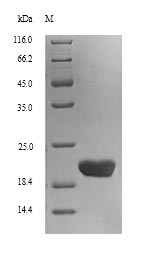Recombinant Human C-type lectin domain family 4 member C (CLEC4C) is produced using a yeast expression system and covers the extracellular domain from amino acids 45 to 213. The protein comes with an N-terminal 6xHis-tag and reaches purity levels above 90% based on SDS-PAGE analysis, which appears to provide high-quality material for research purposes. The recombinant protein seems well-suited for various applications given its consistent production and purity standards.
CLEC4C, which researchers also know as CD303, belongs to the C-type lectin family and likely plays a crucial role in immune system function. It's found mainly on plasmacytoid dendritic cells and is involved in recognizing glycan structures. The protein appears to participate in immune response modulation, making it particularly relevant for studies examining immune signaling pathways and how pathogens interact with host cells. Its role in innate immunity suggests it may be important for understanding how the immune system functions and regulates itself.
Potential Applications
Note: The applications listed below are based on what we know about this protein's biological functions, published research, and experience from experts in the field. However, we haven't fully tested all of these applications ourselves yet. We'd recommend running some preliminary tests first to make sure they work for your specific research goals.
The recombinant human CLEC4C extracellular domain (45–213aa) expressed in yeast with an N-terminal 6×His tag is highly likely to fold correctly because it represents a secreted extracellular domain—a protein type that yeast expression systems generally handle well. Yeast can perform disulfide bond formation and limited glycosylation, both critical for the folding and stability of lectin domains. Therefore, the expressed protein may retain near-native conformation and potential carbohydrate-binding activity, though its bioactivity must be experimentally validated (e.g., through glycan binding assays or circular dichroism spectroscopy). In summary, the probability of correct folding is high, but it cannot be assumed without direct verification.
1. Antibody Development and Validation Studies
This recombinant CLEC4C extracellular domain is well-suited as an immunogen for producing antibodies against human CLEC4C or for validating existing antibodies. The N-terminal 6×His tag facilitates purification and immobilization in ELISA or Western blot assays, and >90% purity ensures reliability across experiments. If correctly folded, this protein can elicit and detect antibodies that recognize native, conformational epitopes of CLEC4C. If misfolded, it will still serve effectively for generating linear-epitope antibodies, suitable for denatured assays like Western blotting. Thus, while folding is likely correct due to the yeast system’s secretion capacity, antibody binding to native CLEC4C should be confirmed empirically.
2. Protein-Protein Interaction Studies
The purified CLEC4C extracellular domain can be used to identify binding partners or ligands if the protein retains its native conformation. The 6×His tag simplifies immobilization for pull-down, SPR, or bio-layer interferometry assays. However, because the binding specificity of lectin domains depends heavily on correct disulfide pairing and glycosylation, experimental validation of folding and carbohydrate-recognition competence is required before assuming functional activity. If folding validation is lacking, the fragment should be used only for preliminary binding screening, not for quantitative affinity or mechanistic studies.
3. Structural and Biophysical Characterization
This recombinant extracellular domain is a suitable candidate for structural and biophysical studies if it is confirmed to be properly folded. Its defined amino acid boundaries (45–213aa) and >90% purity make it amenable to crystallography, NMR, or CD spectroscopy. However, yeast-derived glycosylation can sometimes interfere with crystallization or cause heterogeneity, so deglycosylation treatment or expression optimization may be necessary. Without confirmation of correct folding and homogeneity, it should not be used for high-resolution structure determination.
4. Lectin Activity and Carbohydrate Binding Assays
If the recombinant protein is correctly folded, it can be used in glycan array screening or carbohydrate binding assays to define CLEC4C’s ligand specificity. The 6×His tag allows easy immobilization for biosensor or microplate-based assays. If folding or glycosylation is incomplete, the protein might show reduced or absent lectin activity despite structural integrity. Therefore, functional glycan binding must be empirically verified before assuming activity.
Final Recommendation & Action Plan
The recombinant human CLEC4C extracellular domain is very likely to be correctly folded and partially bioactive, given that yeast can produce functional extracellular lectins with proper disulfide formation. It is well-suited for antibody generation, validation studies, and potential carbohydrate-binding assays, provided folding is confirmed through secondary structure and binding analyses.






